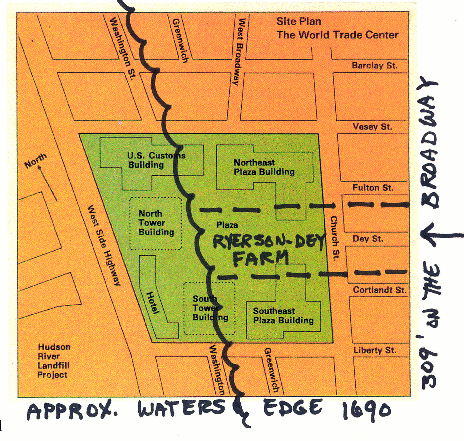|
Rewind to the year 1690
After his marriage to the widow Anneken (Schouten) Dey in 1691, Joris Ryerson
took over the operation of her farm on New Amsterdams Broad Way. It is described as containing 5-1/2 acres, with 309 feet
frontage along the Broad Way and 800+ feet west to the waters edge - the waters of the Hudson River. Here they settled down
to raise her 3 children - plus 11 of their own! Like his father, Joris probably planted tobacco. The old wagon lane on their
farm would come to be known as Dey Street.
Of all our ancestors, Joris was the most casual about his name. The 1703 census
of New York City lists him as Jores Riersie while in later years he was known as both George Ryerse and George Ryersen. His
family lived on this farm for 17 years before they moved across the Hudson River to New Jersey. The little
farm would be inherited by Annekens 3 children, as you will learn.
300+ Years of Incredible History!
This was a historically significant piece
of property long before Joris and Anneken came to live there. In the fall of 1613, a few years after Henry Hudson discovered
the great river that bears his name, a trading ship named TIGER captained by Adriaen Block, rode at anchor just off
Manhattan Island. It was loaded with a valuable cargo of beaver, otter and other skins and was preparing to sail back to Holland.
Unfortunately, a fire broke out on board and was soon out of control. The crew managed to salvage a few spare sails, tools
and fittings before they escaped the flaming vessel. The TIGER burned to the water line, her cargo of pelts a total
loss, her charred hull beached at the foot of what would become the Ryerson farm. Undaunted, Capt. Block and his crew camped
nearby and worked all winter, felling sturdy oaks and hickories that lined the shore and set to work laying the keel of a
new ship. By spring they were again ready to sail.
The flame-charred hull of the TIGER lay buried for hundreds
of years until 1916 when a workmans shovel revealed several of its solid oak timbers. They lay twenty feet below the surface
of the street which was being excavated for a subway extension. These fragments are now preserved and on display at the Museum
of the City of New York.
In September of 1776 during the Revolutionary War,
a fire broke out in lower Manhattan which destroyed about a quarter of the city, 493 houses and a path of desolation a mile
long - including the old family farm! No one is sure whether the fire was set by the British troops or the American patriots!
In 1835, a second great fire raged through
Broad Street, Wall Street and the East River area, destroying seven hundred buildings - among them the last remnants of old
New Amsterdam. After this fire, elegant mansions were built and the tillable land sloping gently down to the banks of the
Hudson on the old Ryerson farm became a very select neighborhood. By the 1850s, however, these had all been torn down and
in their place rose marvels of engineering skill - great office buildings.
The World Trade Towers - 1977
The shoreline along the Hudson River was filled in over the years,
extending several blocks beyond the waters edge of Joris farm. It was from this partially reclaimed fill land and partially
the old Ryerson farm, that rose the magnificent twin towers of the World Trade Center, soaring 110 floors - a quarter of a
mile - into the air above the very bedrock foundations of our little farm! ( see map)


|
| AP photo |
Recent Excitement!
The old family farm has been the site of recent excitement as well. In 1974, the World Trade Center was the scene of a
dare-devil stunt when a high-wire aerialist stretched a wire between the top of the two towers and walked bravely across!
In 1977 an amateur mountain climber scaled the outside of one of the 1350 foot towers! Great crowds gathered
to watch these feats. And again, a third dare-devil would sky-dive from the roof, free-falling 600 feet before opening his
chute! Stiff fines and tighter security discouraged any further fool-hardy stunts!
A Deadly Blast - 1993
In 1993, a deadly blast caused by a terrorist bomb ripped through the underground garage of this New York skyscraper. Five
people were killed, over 600 injured and thousands more were forced to flee down dark, smoke-filled stairwells.
September 11, 2001
None of us will ever forget the vicious act of vile cowardice that
occurred on this date. We can only shake our heads in stunned silence at the events that have taken place. The overwhelming
loss of life and property can never be counted. We watch with profound sadness as thousands of bodies are unearthed and the
immense pile of rubble -- estimates of 1-1/2 million tons -- is slowly carted away.
The only visible remains of the old family farm is a street
sign!
The DEY/RYERSON Connection
Dirck Jansen Dey was a soldier in the employ of the Dutch West India Company who arrived in New Amsterdam
in 1641. He acquired land at the corner of Broadway and Dey Streets, located just outside the "wall" and beyond the land gate
into New Amsterdam. For this land he paid a yearly rental to the Governor of 600 guilders in wampum. He also held a lease
on a piece of land nearby where now stands Trinity Church. At his death in 1687, his son Theunis took over both of these holdings.
Theunis married Anneken Schouten in 1685 but died in 1689 leaving one half of this property to his young widow and the other
half to his three small children. Joris Ryerson would raise these children as his own. The youngest of these, Dirck Dey would
live in New Jersey for many years and built there the famed Dey Mansion, one of the greatest Colonial houses in the northeast
U.S.
In 1752, he left that property to his son Theunis and returned to the property he still owned in New York.
That property at the corner of Greenwich and Dey Street is shown in this watercolor painted by the Baroness De Neuville in
1810. The Dey house is the large two-story structure in the center foreground. Other pieces of the old farm were sold off
at different times. A lot at the southwest corner of Dey St. sold for 75 pounds in 1745. A plot 25 x 28 on the south side
of Dey sold for 50 pounds in 1747 and the property in the picture shown here was sold in 1810, a few months after this painting
was finished.
A personal note --- my youngest daughter and her new husband were
in New York a week before this tragedy and did "the tourist thing" by riding the high speed elevators to the top of the World
Trade. They sent me this picture taken from the observation tower showing Tiffany standing in front of those huge windows
looking out over the NY skyline. It is very hard to comprehend that the floor under her feet and those great glass windows
behind her are now 110 floors below in a smoldering heap of debris and rubble. I am profoundly grateful to the Lord for bringing
them out of harm's way before all of this happened.
Tiffany will never forget this visit to the old family farm!
In July of 2001, a 99 year lease for the World Trade Center property was purchased by a group of investors
and developers. The price tag - $3.2 billion.
The twin towers were fully insured and there are tentative discussions for rebuilding - perhaps in a different
form.
Phyllis Ryerse
|

